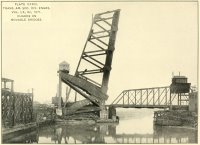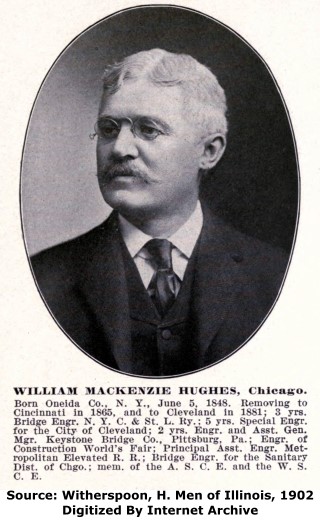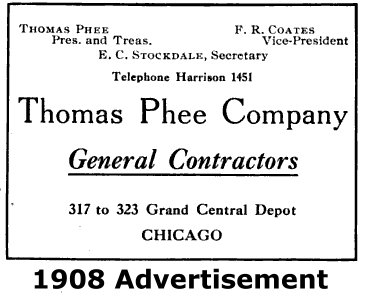We Recommend:
Bach Steel - Experts at historic truss bridge restoration.
BridgeHunter.com Phase 1 is released to the public! - Visit Now
Chicago and Alton Railroad Bridge

Primary Photographer(s): Nathan Holth
Bridge Documented: 2008, June 2010, June 2011, and January 30, 2016
Railroad (Metra Heritage Corridor, Amtrak, and Canadian National) Over South Fork South Branch Chicago River (Bubbly Creek)
Chicago: Cook County, Illinois: United States
Metal 5 Panel Rivet-Connected Warren (No Verticals) Through Truss, Movable: Single Leaf Bascule (Page) and Approach Spans: Metal Girder, Fixed
1906 By Builder/Contractor: American Bridge Company of New York, New York and Engineer/Design: William M. Hughes of Chicago, Illinois
Not Available or Not Applicable
150.0 Feet (45.7 Meters)
214.0 Feet (65.2 Meters)
34.3 Feet (10.45 Meters)
1 Main Span(s) and 1 Approach Span(s)
Not Applicable

View Information About HSR Ratings
Bridge Documentation
View Historic American Engineering Record (HAER) Documentation For This Bridge
HAER Data Pages, PDF
View The Original Patent For The Page Bascule Bridge
View A Detailed 1907 Article About This Bridge
View A Guide To The Canal Produced By Chicago and Alton Railroad
This bridge is an extremely rare example of a Page bascule bridge. The Page bascule's unusual appearance was a patented design in which the counterweight was built into the approach system. It is one of the only remaining examples left of this noteworthy and unusual movable bridge form. This bridge was also designed such that the machinery and other equipment actually acts as part of the bridge's counterweight. In a city that has more movable bridges than any other city in the world, this bridge stands out as one of the most unusual and unique movable bridges in Chicago.

The bridge was reportedly the first Page bascule railroad bridge ever built. It also was reported to be the largest bascule bridge in the world when built, a record that several of Chicago's bridges have held for (often brief) periods of time following their completion. The distinctively shaped curvy racks of this bridge (upon which the pinions run) were noted as the largest individual sections of structural steel ever fabricated to that date in Chicago. Although the Chicago and Alton Railway was the "lead railroad" in supervising the construction of the bridge, it was a joint project including the Illinois Central and Atchison, Topeka, and Santa Fe Railroads as well. Wisconsin Central also had trackage rights upon completion of the bridge under Illinois Central. Work begun on the bridge in March of 1905. The bridge was nearly completed by the end of the year. American Bridge Company was the superstructure contractor, with the steel coming from the Lassig plant in Chicago. G. P. Nichols and Brother of Chicago was the electrical contractor. Thomas Phee Company of Chicago was the substructure contractor. Kelly-Atkinson Construction Company of Chicago erected the superstructure.
Above: Photo showing previous bridge at this location, ca. 1902.

Above: Photo showing previous bridge at this location.
The bridge was constructed as a replacement for a former bridge which was kept open during construction. The former bridge was a bobtail swing bridge dating to the 1880s. The construction plan included 24 hours to make the switch from the previous bridge to the new bridge, with an expectation that it would be done in only 10 hours. However, the previous bridge's pinned connections were more rusted that thought and they had difficulty getting them apart during demolition. As a result, it took nearly 25 hours before railroad traffic was again flowing.
Be sure to view the 1907 article (link provided at top of this narrative) which includes several original engineering drawings of the bridge, several photos, and a detailed discussion of the bridge. This article provided the majority of information seen in this HistoricBridges.org narrative.
Sadly, this bridge no longer lifts for boats today. Worse, because of the unusual design of this bridge, it can be difficult to imagine how this bridge's parts work to move the bridge. Fortunately, there is a historical photo, shown to the right, which shows the bridge in its raised position which helps to show the manner in which the bridge lifts. Also note that the drawing shown at the top of this narrative has a shadow underlay that shows the bridge in the raised position.
The bridge is hard to photograph, but if you ride the CTA Orange Line and get off at the Ashland Station, views of this bridge can be had from the station platform.

The following text below and picture above are from The Bridgemen's Magazine Vol. 7, 1907, Digitized By Google.
The accompanying pictures are of the Page Bascule bridge,
erected at Bridgeport, Chicago, over the
south fork of the
Chicago River, better known as "Babbly Creek," to replace the
Bridgeport draw. The
contract for the superstructure was let to
the American Bridge Company and the erection was done by
Kelly-Atkinson Construction Company. T. C. Fisher was in charge of
the work, which was done by the
members of Local No. 1. It is
the largest bascule bridge In the world, 150 feet in length and a
total
weight of 1,130 tons, divided as follows; 550-ton
counterweight, 250 tons of which is cast iron and
the remainder
punchings, scrap iron, etc., mixed with concrete; 47 tons machinery
and 530 tons
structural steel. The rack guides are the largest
pieces of structural steel ever turned out in
Chicago, each
weighing 70 tons and measuring over 75 feet in length.
The
work was done in very good time, considering the delay caused by
traffic, for four lines of
railway cross the span, running over
50 passenger trains during the working day of eight hours.
Wishing you success, I am,
Very truly yours,
FRED F.
BUCK.
Monessen, Pa
|
Owner Plaque BUILT 1906BY THE CHICAGO & ALTON RY. CO. G H KIMBALL CHIEF ENGINEER W H HUGHES CONSULTING ENG'R PAGE & SHNABLE PATENTEES |
Builder Plaque AMERICAN BRIDGE COOF NEW YORK CONTRACTORS FOR SUPERSTRUCTURE THOMAS PHEE & CO CONTRACTORS FOR SUBSTRUCTURE |
Information and Findings From Chicago Landmarks DesignationGeneral Information Address: East of Ashland Ave., North of Archer Ave.
(South Fork of the South Branch of the Chicago River) This Bridge Is A Designated Chicago Landmark |
![]()
Historic Bridges of Chicago and Cook County


Chicago and Cook County are home to one of the largest collections of historic bridges in the country, and no other city in the world has more movable bridges. HistoricBridges.org is proud to offer the most extensive coverage of historic Chicago bridges on the Internet.
General Chicago / Cook County Bridge Resources
Chicago's Bridges - By Nathan Holth, author of HistoricBridges.org, this book provides a discussion of the history of Chicago's movable bridges, and includes a virtual tour discussing all movable bridges remaining in Chicago today. Despite this broad coverage, the book is presented in a compact format that is easy to take with you and carry around for reference on a visit to Chicago. The book includes dozens of full color photos. Only $9.95 U.S! ($11.95 Canadian). Order on Amazon.
Chicago River Bridges - By Patrick T. McBriarty, this is a great companion to Holth's book shown above. This much larger book offers an extremely in-depth exploration of Chicago's movable highway bridges, including many crossings that have not existed for many years. Order Now Direct From The Publisher! or order on Amazon.
View Historic American Engineering Record (HAER) Overview of Chicago Bascule Bridges (HAER Data Pages, PDF)
Chicago Loop Bridges - Chicago Loop Bridges is another website on the Internet that is a great companion to the HistoricBridges.org coverage of the 18 movable bridges within the Chicago Loop. This website includes additional information such as connections to popular culture, overview discussions and essays about Chicago's movable bridges, additional videos, and current news and events relating to the bridges.
Additional Online Articles and Resources - This page is a large gathering of interesting articles and resources that HistoricBridges.org has uncovered during research, but which were not specific to a particular bridge listing.
![]()
Photo Galleries and Videos: Chicago and Alton Railroad Bridge
Bridge Photo-Documentation
Original / Full Size PhotosA collection of overview and detail photos. This gallery offers photos in the highest available resolution and file size in a touch-friendly popup viewer.
Alternatively, Browse Without Using Viewer
![]()
Bridge Photo-Documentation
Mobile Optimized PhotosA collection of overview and detail photos. This gallery features data-friendly, fast-loading photos in a touch-friendly popup viewer.
Alternatively, Browse Without Using Viewer
![]()
Maps and Links: Chicago and Alton Railroad Bridge
Coordinates (Latitude, Longitude):
Search For Additional Bridge Listings:
Bridgehunter.com: View listed bridges within 0.5 miles (0.8 kilometers) of this bridge.
Bridgehunter.com: View listed bridges within 10 miles (16 kilometers) of this bridge.
Additional Maps:
Google Streetview (If Available)
GeoHack (Additional Links and Coordinates)
Apple Maps (Via DuckDuckGo Search)
Apple Maps (Apple devices only)
Android: Open Location In Your Map or GPS App
Flickr Gallery (Find Nearby Photos)
Wikimedia Commons (Find Nearby Photos)
Directions Via Sygic For Android
Directions Via Sygic For iOS and Android Dolphin Browser
USGS National Map (United States Only)
Historical USGS Topo Maps (United States Only)
Historic Aerials (United States Only)
CalTopo Maps (United States Only)









